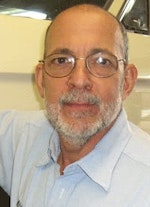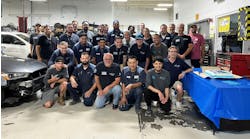The one place I never expected to find inspiration or pause for reflection was the magazine that lives in the back seat pocket of every seat on just about every American Airlines plane. I suppose there are numerous reasons for this. First of all, I don't often read that magazine. In fact, it would be safe to say I almost never read that magazine. Not because it isn't very good or even because I don't like it. I generally find the magazine entertaining when I do read it. The problem I have is time.
I'm almost always too busy doing something "more productive" like preparing for whatever it is I have to do whenever I get to wherever it is I'm going, which is generally the reason I find myself reflecting on things like this at a cruising altitude of 37,000 feet.
This time I ran out of batteries before I ran out of things to do, and that loss of power left me searching for something to fill the remaining hour and 50 minutes until we reached our final destination.
You see, I've known about "the flow" for most of my adult life.After working my way through an interview with Charles Schwab, founder of the investment company that bears his name, I came across an article entitled "Go With The Flow." Frankly, I had no idea what it was all about until I finished the first paragraph and realized I had just stumbled upon something profound: something possibly responsible for the majority of us being here, something responsible for more than a few of us remaining here.
The article described a state I know I have experienced, one I am sure you have encountered as well: that place where your attention and concentration are so focused, so fully engaged, time stands still and virtually everything else ceases to exist. This kind of calm intensity, the almost "electric connectivity between us and our work," can become addictive, the author warned. Having experienced it, I ? for one ? believe him.
You see I've known about "the flow" for most of my adult life. I just didn't know what to call it. I thought it was a kind of Zen thing, where the work and the worker are one. Now, I was face-to-face with a concept for not only defining what this higher consciousness is all about, but a way to actually cultivate and control it.
I was so intrigued with what I read, I accepted the airline's invitation to take my copy of the magazine home knowing it would serve as the foundation for significantly more research on the subject. When I arrived home, I went straight to the computer and scoured the net for any articles I could find on "the flow," and there were a bunch. It seems the formal study of this phenomenon started in the early '60s with research on happiness by Mihaly Csikszentmihaly (pronounced chick-sent-me-high-ee), a psychologist at the University of Chicago.
At first glance, the results of his research seem almost counter-
intuitive. They certainly run contrary to the theories that suggest that happiness, fulfillment and satisfaction are the result of the completion of a difficult task or the culmination of reaching a powerful personal or professional goal or objective. Those of us who have committed substantial resources, energy and effort to a task only to find its completion somehow unrewarding and anti-climactic have confirmed that conclusion. It isn't about moving away from pain or toward pleasure or reward either. It's about the work itself. It's about being consumed by the task at hand: fully involved, fully engrossed, fully committed.
This isn't exactly news in the East. Zen monks have known for centuries that the work and the worker are one in the same and that the frustration and anxiety that are the staples of Western work-life are the direct result of any attempt to separate the two.
Complete absorption in whatever it is you are doing is synonymous with "the flow," and the distractions and disruptions that are indicative of life at the counter and sometimes even on the shop floor can be its anti-thesis: the natural opposite and enemy of the flow.
Why am I so sure that you will recognize this state of being once I describe it to you? Because you've been there. You've experienced it. You might have even tried to recapture it a time or two after you've been dragged kicking and screaming out of the flow.
Complete absorption in whatever it is you are doing is synonymous with "the flow."The research started with a simple question: What constitutes fun? What makes some experiences pleasant, satisfying or enjoyable and others not? And what, if anything, could be considered consistent about that experience over a number of different kinds of work and play activities?
What Csikszentmihaly found was that fun, satisfaction or happiness didn't have anything at all to do with relaxation or the absence of anxiety or stress as one might think. Instead, it was related to total absorption: The balance between the difficulty of the task and the effort and ability of the person involved. In other words, the more challenged physically or mentally and the more immersed and fully involved the person engaged, the more likely the phenomenon of flow was to occur. This could, of course, relate to some kinds of recreation, but only those kinds of recreation that required complete and total concentration. More than that, this state of being in the flow was so powerful that anyone who experienced it was likely to struggle to repeat the experience if they could.
All the articles I read suggested that entering the flow begins with a clearly defined task that demands our full and complete attention. This kind of focus results in clear and immediate feedback to the point that even a repetitious and uninteresting task can result in immersion in the flow ? if the skills and abilities of the individual are perfectly balanced with the difficulty of the task. All it requires is involvement so complete that whatever we are doing causes temporary or seemingly irrelevant distractions to disappear. In fact, with tasks involving risk or danger, falling out of the flow ? allowing yourself to be distracted by anything or anyone ? may have serious consequences in the way of accidents or injury.
Does any of this sound familiar to you? Have you ever been working on the shop floor or on a difficult management problem only to look up and find that what seemed like 10 minutes was really more like two hours? Did you ever connect to the point that you don't remember how you did whatever it was you did? All you can recall is that when you came out of the almost trance-like state you were in, the task was somehow completed. I think almost everyone who has ever worked on difficult drivability problems or immersed themselves completely in the wonderful world of broken cars or broken people has been there. I know I have.
Once I started thinking about all of these things, I realized there are things that are conducive to flow and things that are not. Surfing the Net can lead you into the flow if you find yourself fully engrossed or immersed in it. So can significant physical exertion like martial arts forms or Katas. Working on the cars and trucks we are asked to diagnose and repair can be about as flow-friendly as you can get ? provided you are allowed to do it without interruption or distraction. Television, with its dissonant themes, staccato rhythms and constant demand for our attention, is about as flow-fracturing as you can get. So is the environment likely to be found in too many of the automotive service centers across the country where the absence of structure, continuous distractions and countless interruptions have become an integral part of the environment.
It is the river of energy and enjoyment that brought you here.After reading, researching and recognizing the importance of experiencing the flow (and how much it is missed when we are prevented from experiencing it), I started to realize that if we can define it and describe it, we just might be able to control and perhaps even command it.
Well, it seems we can certainly define it. Csikszentmihaly suggests it as a sense of playfulness; a feeling of being in control; deep concentration and highly focused attention; mental enjoyment of the activity, whatever it might be, for its own sake; a distorted sense of time; and an almost perfect balance between the task and one's own levels of skill and ability. It is evidenced by being fully involved in virtually everything we do and with everything that surrounds us, and when it occurs it is accepted to be what most of us have come to know as happiness.
Great! So how do you achieve it? Well there is a technology for virtually everything, and the flow is no different. You start out by trying to make whatever it is you are doing a game, as much as that's possible. Then you attach a challenging, almost impossible goal: something that shouldn't be much of a problem given what you and I are asked to do everyday.
Achieving flow requires an almost perfect balance between what it is you are being asked to do and the skills and ability necessary to do it, as well as the ability to rid your mind of as many distractions as possible and to focus entirely on the task at hand. It demands total concentration: the ability to let go and the opportunity for action and awareness to become one. It results in immediate feedback ? deep involvement that goes beyond the normal distractions we face everyday and our awareness of time. And, the sensation that occurs as the result of all of this can release an untapped reservoir of energy, creativity and resourcefulness.
I guess, in the end, what flow is really all about is creating or recreating the enjoyment and sense of exhilaration that brought us into this industry by understanding where it came from and then consciously seeking it out.
What you have to do, must do, is identify what it takes to find yourself in the flow and then diligently try to eliminate anything and everything that either prevents you from entering it or that pulls you out of it prematurely once you've finally found it. If that means creating the kind of structure that reduces the number of distractions you confront either in the office or on the shop floor, do it. The results are more than worth the effort.
If it takes searching for the fun you once enjoyed fixing cars or working on your business, start that search today. It is the river of energy and enjoyment that probably brought you here in the first place. And don't worry about being the only one looking. You won't be alone, at least not for long. In fact, if you look hard enough you'll probably find me searching for the flow right there alongside you.



